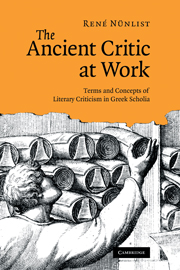Book contents
- Frontmatter
- Contents
- Acknowledgments
- Introduction
- PART I
- 1 Plot
- 2 Time
- 3 Narrative and speech
- 4 Focalisation
- 5 Effects on the reader
- 6 Gaps and omissions
- 7 Poetic licence
- 8 Authentication
- 9 Style
- 10 Allusions, hints, hidden meanings
- 11 Characters
- 12 Mythography
- PART II
- Epilogue
- Glossary of Greek terms
- Editions of scholia
- Other abbreviations
- Bibliography
- Thematic index
- Index locorum
10 - Allusions, hints, hidden meanings
Published online by Cambridge University Press: 29 August 2009
- Frontmatter
- Contents
- Acknowledgments
- Introduction
- PART I
- 1 Plot
- 2 Time
- 3 Narrative and speech
- 4 Focalisation
- 5 Effects on the reader
- 6 Gaps and omissions
- 7 Poetic licence
- 8 Authentication
- 9 Style
- 10 Allusions, hints, hidden meanings
- 11 Characters
- 12 Mythography
- PART II
- Epilogue
- Glossary of Greek terms
- Editions of scholia
- Other abbreviations
- Bibliography
- Thematic index
- Index locorum
Summary
The broad title of this chapter is meant to indicate the wide range of concepts that are covered by the term αἰνίττεσθαι (‘to speak in riddles, hint at’) and its cognates, which constitute the spine of the chapter. If in the following an attempt is made to distinguish between different forms of allusion, etc., it should be stated at the outset that the main purpose of this distinction is to give the material presented here a clearer structure. To judge from the extant evidence, ancient scholars themselves do not seem to have tried to differentiate between the various meanings of αἰνίττεσθαι (which go as far as ‘to express allegorically’), but simply used the term in order to express the ideas discussed below.
ALLUSIONS
In the present context allusion will be understood as ‘a poet's deliberate incorporation of identifiable elements from other sources, preceding or contemporaneous, textual or extratextual’ (Miner 1993: 38–9). Three types of such identifiable elements are discussed in the scholia: (a) historical events and/or persons, (b) stories of traditional mythology, (c) specific works of literature. The main difference between (b) and (c) is that only discussions of the latter type identify the precise source, whereas in the former case a general allusion to a known myth is recognised without specifying its exact source or variant.
- Type
- Chapter
- Information
- The Ancient Critic at WorkTerms and Concepts of Literary Criticism in Greek Scholia, pp. 225 - 237Publisher: Cambridge University PressPrint publication year: 2009



